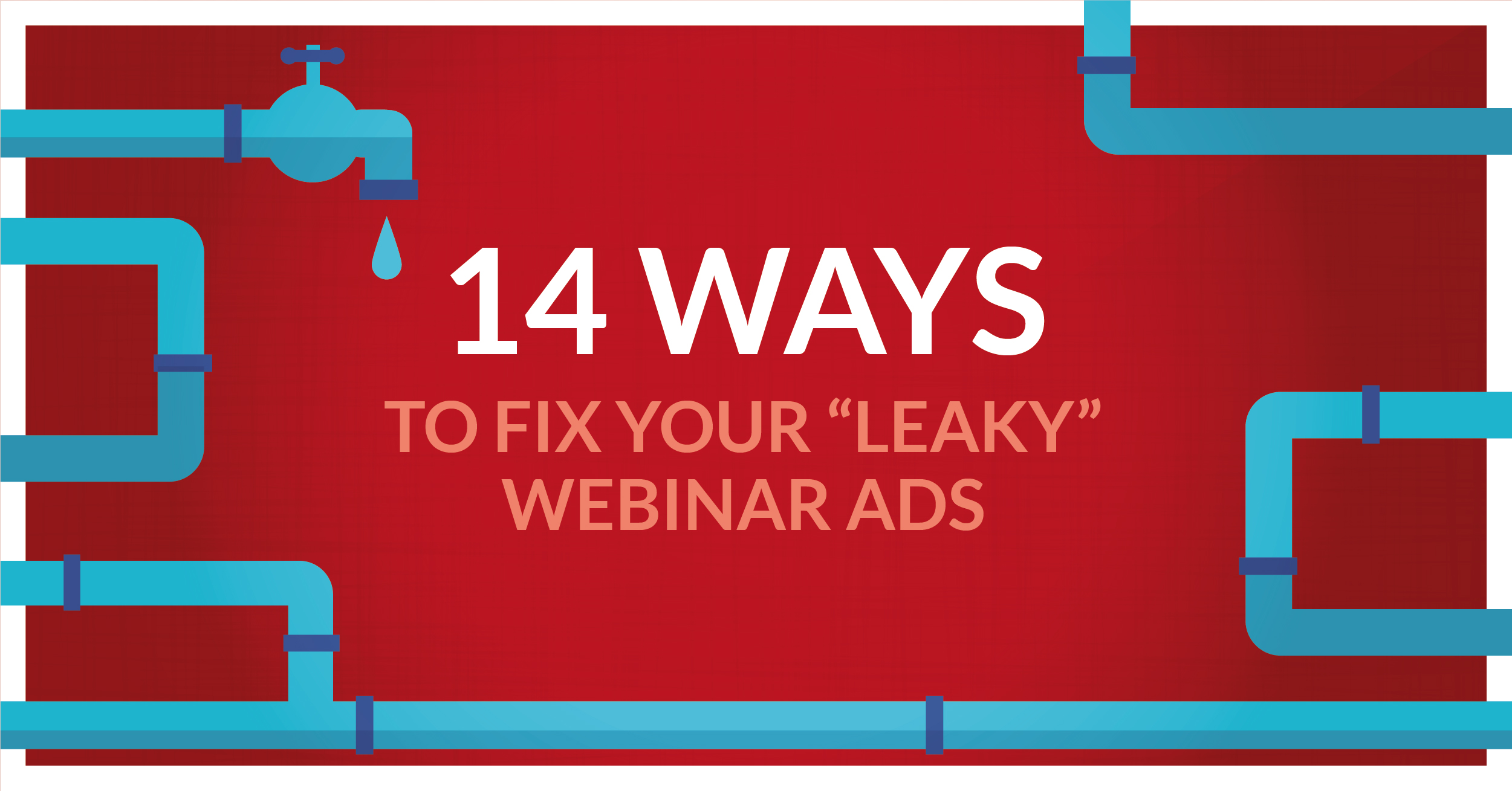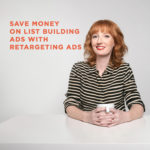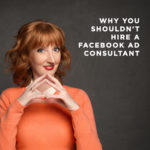Man, oh man. Few words strike fear into the heart of this entrepreneur like the word “webinar.”

Every single time I launch a product, I’m like, “please no, I’ll do anything, ANYTHING but host a webinar. I’ll send an email every 30 minutes! I’ll spend THOUSANDS of dollars on Facebook ads! Just don’t make me go down the webinar path.”
Webinars are a challenge for a lot of people.
The work you have to do for them is insane! You have to:
- Come up with a topic
- Build the sign-up page
- Write all the emails
- Choose the right software
- Post all over social media
- Create the slides
- Craft a pitch, and
- Practice, practice, practice (if you don’t want to make a giant fool of yourself).
But for me, the one thing I hate the absolute most about webinars . . . is the waiting. Knowing that I’m going to be live – and probably judged – at a certain time just makes the entire waiting period so unpleasant.
But something changed for me recently. After taking it off my website for a much needed upgrade, it was finally time to re-publish my mega-course on Facebook ads, Absolute FB Ads. I had about 100 people who had signed up to get notified when it was back on sale, and I thought it was probably a good idea to host a webinar to get them jazzed up about all the things they could potentially do with their ads.
The only reason I went with this idea, though, is because of one thing:
Everything was already done.
In order to promote the same course, I had hosted a webinar earlier in the year. Because I had already gone through the exhaustive to-do list the first time I hosted The 3 Simple Steps to DOUBLE Your Course Sales with Facebook Ads, everything was basically ready to go. I even knew which Facebook ads to turn back on by spending 5 minutes looking at the report from the previous campaign.
The beauty of the 3 Simple Steps webinar is that it gets people excited about the different strategies I teach in my course. And by putting in the time and effort to prepare for that webinar, I created an extremely valuable asset in my business.
In this blog post, my goal is to help you create an equally valuable asset for your business: a system for running your webinar Facebook ads.
Webinars only really work as a sales tool if people show up to watch you. You can definitely get people to attend a webinar by emailing your list, but if you have a small list, or if you’ve already tapped your list multiple times with “here’s a free training” offer, then you’re going to have to expand your reach in order to get new people on your webinar.
Whether you’ve spent thousands on Facebook ads already, or you’re a complete newbie, you will save yourself a ton of money (not to mention A LOT of frustration) by implementing a system for your webinar Facebook ads. I’m going to give you a look at mine right now.
There are three stages to my webinar Facebook ads system:
- The Set-Up
- The Optimization
- The Postmortem
Most people completely BLOW through the set-up (missing a lot of important steps), have no idea what to do during the optimization period, and totally skip the postmortem.
When you run Facebook ads without systematizing the process, you lose your ability to easily duplicate your work later. Every campaign you run feels like a TON of work; starting from scratch means a serious time investment, time that you may not have. (Bet your to-do list is just as long as mine right about now.) So you’re more likely to rush through the whole process, missing crucial steps along the way. Your ads don’t perform that well, and you’re not sure why.
Don’t skip the steps, my friend. When you do, you create a crack in your campaign where your ad budget is likely to leak and make all your results a lot more expensive.
Here are the 14 places in your webinar ads system where you can fix the cracks, save money on your ads, and set yourself up for continued success. Because if you’re here, then you’re someone who’s working to build something sustainable for years to come. (You’re better than those get-rich-quick schemes that don’t work anyway.)
Save yourself a BOATLOAD of time and money.
Click here to grab a copy of the “FACEBOOK ADS FOR WEBINARS THAT SELL” checklist – it’s FREE!
STAGE ONE: THE SET-UP
1. Choose your topic wisely.
It is HARD to get people to take time out of their busy schedules in order to read a blog post, let alone show up live for an online event! So whatever it is that you’ll be teaching on your webinar, it better a) explain how to solve a real problem that I have, and b) help me take action immediately.
The more appealing you can make your webinar topic, and show why it’s important that people pay attention, the cheaper your sign-ups are going to be.
The other important thing to think about when choosing your topic is this: How well does it tie into the offering you’re going to make on the webinar?
I’ve made this mistake more times than I’m proud to admit: I come up with an extremely valuable webinar topic, but then I realize that, while it may be related to the course I’m selling, it isn’t closely related to naturally lead into the sale.
For example, I’ve run a webinar in the past called Prep Your Website for Facebook Ads. Could I have pitched my Facebook ad course at the end of that webinar? Sure – I’m talking about Facebook ads the whole time, and how you need to format and write your opt-in pages.
But the better offering with that webinar topic is my course about how to format and write your opt-in pages, Landing Pages that Convert. You don’t have to make any mental leap to go from the content I teach on the webinar to that course offering at the end.
2. Create a special sign-up page with a unique URL for your Facebook ad traffic.
Want to know the best way to be sure of your Facebook ad ROI? By tagging the people who sign up for your webinar with something that indicates they signed up from a Facebook ad.
That way, if all your tracking goes COMPLETELY HAYWIRE (because, you know, it’s easy to mess up conversion tracking for purchases), you’ll know exactly which of the people who bought on your webinar were paid leads or organic ones.
The way to set this up is to use a special URL in your Facebook ads that goes to a unique sign-up page. In your email provider, you’ll set up the form on said sign-up page to tag those subscribers with a tag called FB ADS + [insert name of your webinar]. Convertkit makes this insanely easy, which is another reason I recommend you use them for all your email marketing. (FYI: that’s my ConvertKit affiliate link.)
3. Use a custom conversion, not a standard event for your conversion tracking.
Here’s the truth: TONS of people set up standard events the wrong way and that’ll severely impact the results of your campaign. It’s far easier to use a custom conversion – all you need is the Facebook pixel placed on your site and the URL of your thank you page. BOOM. You’re tracking conversions, and Facebook can give you an accurate report on which audiences and ads were the most effective.
4. Set aside some budget to target people on your list and site visitors.
One of your goals with hosting a webinar is probably list building, but that doesn’t mean that you should completely exclude people who are already engaged with your business from seeing your ads. Even if you’re emailing your list multiple times before the webinar in order to get them to sign up, don’t fool yourself into thinking that everyone is opening your emails.
If you’re not promoting your webinar to people already engaged with your business, you’re missing out on a huge opportunity. Use ads to your subscribers and to people who have recently visited your site as a low-priced insurance policy: you pay a little to get them to sign up because they’re more likely to buy whatever you’re offering on the webinar.
5. To grow your list with new people, test interest-based versus lookalike audiences.
This is a smart test to run for every one of your list building Facebook ad campaigns. Create an ad set that targets an audience created with options from the Detailed Targeting box.
Then duplicate that ad set, delete the interests inside of the Detailed Targeting box, and scroll up to the Custom Audiences field. Choose one 1% lookalike audience that you’ve built (or build one now), and you’re done.
Once your ads are running, you’ll see clearly which kind of audience gets you the lowest cost-per-lead.
6. Set your ads to run for 7 to 10 days before your webinar happens.
Any longer than 10 days, and people will forget all about your upcoming webinar. (Squirrel!) But you do want about 7 days for your ads to optimize and to find the best target audience and messaging. Chances are your results on Days 4 and 5 are going to be better than on Day 2, so plan to promote accordingly.
7. In your ad copy, focus on the pain point and the outcome.
Listen up, because this could be the difference between ads that get insane results and those that completely flop.
Good copywriting is just as important on your ad as it is on your sales page. Your ad has a big job to do: to get people who are just trying to watch cat gifs to stop scrolling through their News Feed and click over to your sign-up page. So that means you have to be able to show that you can help them overcome a specific problem and achieve a specific transformation.
If you’re writing copy for your ad and you can’t pinpoint the exact outcome (a.k.a. the solution for a specific problem) that people will get, you may need to rework your webinar topic and content.
8. Pay attention to the emails people will get after signing up for your webinar.
I see this happen all the time, and it makes the money you spend on your ads a giant waste:
Because of all the pieces you need to have in place just to collect webinar sign-ups, it’s easy to completely forget about the importance of the “you’re signed up!” email. But I beg of you: give it 10 minutes of your time and attention. This is the first time you’re showing up in these people’s inboxes, so it’s an important step in fostering that relationship.
Sign up for your own webinar, and then check out the email that you receive from yourself. (Haha, I know.) Put yourself in the shoes of someone who has never heard of you before, but who maybe signed up from an ad they saw on their phone. Chances are they aren’t checking their email right away.
Want to get all these steps in one easy-to-use checklist you can save to your own Google Drive account? Click here to get access to to the “Facebook Ads for Webinars that Sell” checklist for free!
STAGE TWO: THE OPTIMIZATION
9. Determine what’s an acceptable cost-per-sign-up.
If some ad sets are bringing in sign-ups for that amount (or for less), great. If they aren’t after 48 hours, turn them off.
10. Double-down on ads that are working.
This hack doesn’t always work, but I make sure to try it every time:
If you have an ad set/audience that’s performing well, duplicate it and change nothing. Let both the original and the duplicate ad set run and see how they perform. This is how to scale the budget of a high-performing ad set without messing with Facebook’s optimization.
11. Two to three days before your webinar happens, run reminder ads to people who have signed up.
In the ad text, remind them why they don’t want to miss your webinar. If there will be some kind of fast-action bonus for people who attend live, make sure to highlight it.
Map out ALL the important dates and tasks on the “Facebook Ads for Webinars that Sell” Checklist.
Click here to sign up for your free copy!
STAGE THREE: THE POSTMORTEM
12. Create a document to record what you learn from your Facebook ad campaign.
Do a deep dive into your campaign’s reports and make a note of the trends you see. Did some images or ad copy get you more sign-ups than others? Did Facebook show your ads evenly? (Probably not.) Were your best audiences lookalike or interest-based?
13. Assess the conversion rate of your sign-up page.
Your ads aren’t the only thing that determine the success of a paid traffic campaign; if you get a lot of visits to your sign-up page, but not a lot of sign-ups, there’s probably a lot of room for you to increase the conversion rate of this page.
To find out your conversion rate, divide the number of sign-ups you got from your Facebook ads by the number of link clicks you got. (You can find that number in the reports.)
If your conversion rate is 30% or higher, you’re in good shape. You may see a higher conversion rate on the page that you sent your subscribers to because Facebook ad traffic often converts at a lower rate.
14. Plan to run the same webinar again . . . soon.
Even if you’ve already wrapped up your launch, you can still run the exact same webinar again. You’ve got all the pieces in place – all you need to do is to change out some dates!
Using what you learned in your Facebook ad postmortem, to improve your ad results and your sign-up page’s conversion rate. Don’t give up if this campaign didn’t kill it – keep sharpening your Facebook ad and webinar-hosting skills, and you’ll definitely see improvements over time!
Track your data, record your takeaways and make your plan for the next webinar in the Facebook Ads for Webinars that Sell Checklist. Sign up for instant access here.
Best of luck on your next webinar! Make sure you let me know how it goes. :) And if you liked this post, I’d love for you to share it!
Plug the leaks of your webinar Facebook ads and get more sign-ups for less money!
Sign up to get your free copy of the Facebook Ads for Webinars checklist! You'll use it for every webinar you ever run in your business.











Thank you Claire. I always find your advice to be spot on. My only issue is that I’m a right-brained creative and run a creative biz for creatives. I have been running 2 webinars a month, and have practiced some of what you mention here. But there is a limit to my technical understanding and capability, and since I’m building my biz I rarely have the funds to spend on a VA. So, my efforts are probably half as successful as they could be. Much of what you suggest here, a person like me is barely capable of. I’m not putting myself down, but having to navigate a largely left-brained world – being a more right-brained creative, is not pretty. It gets to be a maze, and so many of my artist friends feel the same way. I know that you’re trying to help people like me understand, it’s just that it’s not our zone of genius, and until we have the $$ to hire people like you, we’re making slow progress compared to other technologically savvy entrepreneurs. Just needed to say this. :)
Hi Nina, thank you SO much for your comment. Your experience is no doubt one that many of my readers can completely identify with! So your vulnerability around this topic is really appreciated.
I’m going to put on my Tough Coach hat for the moment because I think you’ll benefit from it: if you say you can’t do the things on this list, then you can’t.
I’m in the middle of planning and implementing something that is VERY scary for me at the moment. I have a lot of resistance to it and I mostly want to run away and watch Netflix. But I make a list of all the things I need to do, and I go through that list one by one. It’s slow going, but it’s getting done.
Congrats on doing 2 webinars per month – that is HUGE considering all the work involved! If you’re savvy enough to figure out how to host a webinar, you’re savvy enough to take one thing on my checklist per month and learn how to implement it, one thing at a time.
How does that idea feel?
Hi Claire – wow – thanks for taking the time to reply, and for putting your coach cap on. :) Thanks for the kind words about my 2 webinar a month plan. :) I AM proud of myself for that – and for working through so many of the things I have. The truth about my webinars is that although I can run the show, the set up and automation has been done by my VA. I write the content for the emails of course – but all of the rest is up to her. So I’m really not sure I’m savvy enough to take on the things on your list! :) I reached a point about 6 months ago where I just shut down around tech. I was spinning my wheels (to the point of tears) and I would lose a whole day of work in utter frustration. (The affirmation of “I feel so dumb” does not help!) That’s when I hired a great VA. But I can’t afford her services very often, so it’s slow going. What I do know about what you’re suggesting above is that when I asked my VA to write up step by step instructions, I can do anything. (It doesn’t require my translating facebook’s confusing and non-existent non-instructions!) You’re great because you decipher these things for us. So, I will be brave and get your checklist because I can see now through the blur that you have broken things down in a way that I MIGHT not spin out around. :) It would behoove me to get better results from my webinars. (I have a small list – 350 people – 435 on my fb biz page) and I seem to get a repeat of the same 20 or so people signing up for my webinars. I know I can do so much better and I really appreciate all you do. As I said, I’ve followed
your posts before….Wish me luck! Gulp. :)